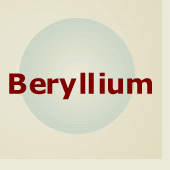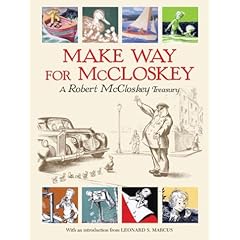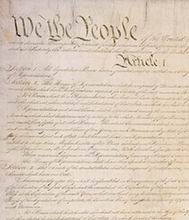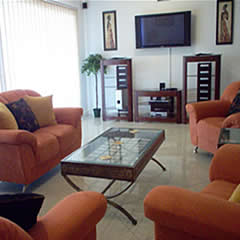Beryllium (
IPA:
/bəˈrɪliəm/) is the
chemical element that has the symbol
Be and
atomic number 4. A
bivalent element, elemental beryllium is a steel grey, strong, light-weight yet brittle,
alkaline earth metal. It is primarily used as a hardening agent in
alloys (most notably
beryllium copper).
Notable characteristics The name beryllium comes from the
Greek βερυλλος,
beryllos, beryl, from
Prakrit veruliya, from
Pāli veuriya; possibly from or simply akin to a
Dravidian source represented by
Tamil veiruor,
viar, "to whiten, become pale.") . This element was discovered by
Louis-Nicolas Vauquelin in
1798 as the oxide in
beryl and in
emeralds.
Friedrich Wöhler and
A. A. Bussy independently isolated the metal in
1828 by reacting
potassium and
beryllium chloride.
Occurrence on Earth Applications Thin sheets of beryllium foil are used with
X-ray detection diagnostics to filter out visible light and allow only X-rays to be detected.
Sheets of beryllium ranging from 3mm (0.125") thick down to 25µm (0.001") thick are used as the output window in x-ray tubes, allowing x-rays to leave the tube while keeping a vacuum on the inside of the tube.
Beryllium metal is, due to its stiffness, light weight, and dimensional stability over a wide temperature range, used in the defense and aerospace industries as light-weight structural materials in high-speed aircraft, missiles, space vehicles and
communication satellites. For example, many high-quality liquid fueled rockets use nozzles of pure Be, an example being the
Saturn V.
Beryllium is used as an
alloying agent in the production of
beryllium copper, containing up to 2.5% beryllium. Beryllium-copper alloys are used in a wide variety of applications because of their combination of high
electrical and
thermal conductivity, high strength and
hardness, nonmagnetic properties, along with good corrosion and fatigue resistance. These applications include the making of spot-
welding electrodes,
springs, non-sparking tools and
electrical contacts.
In the field of
X-ray lithography beryllium is used for the reproduction of microscopic
integrated circuits.
In the
telecommunications industry, tools made of Beryllium are used to tune the highly magnetic
klystrons used for high power
microwave applications.
Because it has a low
thermal neutron absorption cross section, the nuclear power industry uses it in
nuclear reactors as a neutron reflector and moderator.
Beryllium is used in
nuclear weapons for similar reasons. For example, the
critical mass of a plutonium sphere is significantly reduced if the plutonium is surrounded by a beryllium shell.
Beryllium copper is used in electrical spring contacts.
Beryllium is sometimes used in
neutron sources, in which the beryllium is mixed with an alpha emitter such as
Beryllium has been used in
tweeter and
mid-range audio
loudspeaker construction as an alternative to
titanium and
aluminium, largely due to its lower density and greater rigidity.
Because of its low
atomic number beryllium is almost transparent to energetic electrically charged
particles. Therefore it is used to build the
beam pipe around the collision region in
collider particle physics experiments. Notably all four main detector experiments at the
Large Hadron Collider accelerator (
ALICE,
ATLAS,
CMS,
LHCb) use a beryllium beam-pipe.
Can be found in jewelry, as in a tie tack or clip.
As metal and alloys See also Beryllium compounds.
Beryllium is an effective p-type dopant in III-V compound semiconductors. It is widely used in materials such as GaAs, AlGaAs, InGaAs, and InAlAs grown by molecular beam epitaxy (MBE).
Beryllium oxide is useful for many applications that require an excellent heat conductor, with high strength and hardness, with a very high melting point, and that acts as an electrical insulator.
Beryllium compounds were once used in
fluorescent lighting tubes, but this use was discontinued because of
berylliosis in the workers manufacturing the tubes (see below).
As compounds Of beryllium's
isotopes, only Be are known to exhibit a
nuclear halo.
Isotopes Health effects According to the
International Agency for Research on Cancer (IARC), beryllium and beryllium compounds are
Category 1 carcinogens; they are carcinogenic to both animals and humans. Chronic
berylliosis is a
pulmonary and
systemic granulomatous disease caused by exposure to beryllium. Acute beryllium disease in the form of
chemical pneumonitis was first reported in Europe in 1933 and in the United States in 1943. Cases of chronic berylliosis were first described in 1946 among workers in plants manufacturing
fluorescent lamps in
Massachusetts. Chronic berylliosis resembles
sarcoidosis in many respects, and the differential diagnosis is often difficult.
Although the use of beryllium compounds in fluorescent lighting tubes was discontinued in 1949, potential for exposure to beryllium exists in the nuclear and aerospace industries and in the refining of beryllium metal and melting of beryllium-containing alloys, the manufacturing of electronic devices, and the handling of other beryllium-containing material.
Early researchers tasted beryllium and its various compounds for sweetness in order to verify its presence. Modern diagnostic equipment no longer necessitates this highly risky procedure and no attempt should be made to ingest this substance. Beryllium and its compounds should be handled with great care and special precautions must be taken when carrying out any activity which could result in the release of beryllium dust (
lung cancer is a possible result of prolonged exposure to beryllium laden dust).
This substance can be handled safely if certain procedures are followed. No attempt should be made to work with beryllium before familiarization with correct handling procedures.
A successful test for beryllium on different surface areas has been recently developed. The procedure uses fluorescence when beryllium is bound to sulfonated hydroxybenzoquinoline to detect up to 10 times lower than the recommended limit for beryllium concentration in the work place. Fluorescence increases with increasing beryllium concentration. The new procedure has been successfully tested on a variety of surfaces.
 Precautions
Precautions Beryllium can be harmful if inhaled and the effects depend on period of exposure. If beryllium air levels are high enough (greater than 100 µg/m³), an acute condition can result, called acute beryllium disease, which resembles
pneumonia. Occupational and community air standards are effective in preventing most acute lung damage. Long term exposure to beryllium can increase the risk of developing
lung cancer. The more common and serious health hazard from beryllium today is chronic beryllium disease (CBD), discussed below. It continues to occur in industries as diverse as metal recycling, dental laboratories, alloy manufacturing, nuclear weapons production, defense industries, and metal machine shops that work with alloys containing small amounts of beryllium.
Inhalation Some people (1-15%) become sensitive to beryllium. These individuals may develop an inflammatory reaction that principally targets the respiratory system and skin. This condition is called chronic beryllium disease (CBD), and can occur within a few months or many years after exposure to higher than normal levels of beryllium (greater than 0.02 µg/m³). This disease causes fatigue, weakness, night sweats and can cause difficulty in breathing and a persistent dry cough. It can result in anorexia, weight loss, and may also lead to right-side heart enlargement and heart disease in advanced cases. Some people who are sensitized to beryllium may not have any symptoms. The disease is treatable, but not curable with traditional drugs and medicine. CBD occurs when the body's
immune system recognizes beryllium particles as foreign material and mounts an immune system attack against the particles. Because these particles are typically inhaled into the lungs, the lungs become the major site where the immune system responds, they become inflamed and fill with large numbers of
white blood cells that accumulate wherever beryllium particles are found. These cells form balls around the beryllium particles called "
granulomas." When enough of these develop, they interfere with the normal function of the organ. Over time, the lungs become stiff and lose their ability to help transfer oxygen from the air into the bloodstream. Patients with CBD develop difficulty inhaling and exhaling sufficient amounts of air, and the amount of oxygen in their bloodstreams falls. Treatment of such patients includes use of oxygen and medicines that try to suppress the immune system's over-reaction to beryllium. A class of immunosuppressive medicines called
glucocorticoids (example:
prednisone) is most commonly used as treatment. The general population is unlikely to develop acute or chronic beryllium disease because ambient air levels of beryllium are normally very low (0.00003-0.0002 µg/m³).
Chronic beryllium disease (CBD) Swallowing beryllium has not been reported to cause effects in humans because very little beryllium is absorbed from the stomach and intestines. Ulcers have been seen in dogs ingesting beryllium in the diet.
Ingestion Beryllium can cause
contact dermatitis. Beryllium contact with skin that has been scraped or cut may cause
rashes, ulcers, or bumps under the skin called
granulomas.
Dermatological effects There are no studies on the health effects of children exposed to beryllium, although individual cases of CBD have been reported in children of beryllium workers from the 1940s. It is likely that the health effects seen in children exposed to beryllium will be similar to the effects seen in adults. It is unknown whether children differ from adults in their susceptibility to beryllium. It is unclear whether beryllium is
teratogenic.
Effects on children Beryllium can be measured in the urine and blood. The amount of beryllium in blood or urine may not indicate time or quantity of exposure. Beryllium levels can also be measured in lung and skin samples. While such measurements may help establish that exposure has occurred, other tests are used to determine if that exposure has resulted in health effects. A blood test, the blood beryllium lymphocyte proliferation test (BeLPT), identifies beryllium sensitization and has predictive value for CBD. The BeLPT has become the standard test for detecting beryllium sensitization and CBD in individuals who are suspected of having CBD and to help distinguish it from similar conditions such as sarcoidosis. It is also the main test used in industry health programs to monitor whether disease is occurring among current and former workers who have been exposed to beryllium on the job. The test can detect disease that is at an early stage, or can detect disease at more advanced stages of illness as well. The BeLPT can also be performed using cells obtained from a person's lung by a procedure called "bronchoscopy."
 Industrial release and occupational exposure limits Category:Beryllium compounds
Industrial release and occupational exposure limits Category:Beryllium compounds Beryllium's entries at
fictional applications of real materials Sucker Bait, a story by
Isaac Asimov in which the health hazard of beryllium dust is an important plot point




 Class 3 seat
Class 3 seat Precautions
Precautions Industrial release and occupational exposure limits
Industrial release and occupational exposure limits Population
Population Examples of upmarket goods
Examples of upmarket goods Uncovered Editions
Uncovered Editions



 See also
See also
 Lefthit
Lefthit